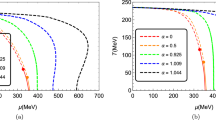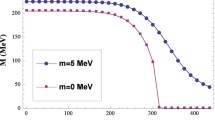Abstract
A midpoint method is introduced to calculate the chiral phase transition and thermodynamic properties in the Nambu-Jona-Lasinio (NJL) model with two flavors (u,d). The constituent quark mass, the pressure, the energy density, and the entropy are calculated in the mean-field approximation using the midpoint technique. The phase transition was found to be crossover for all values of bare quark mass. The effect of finite temperature and chemical potential on the thermodynamic properties is studied. A comparison with other models is presented. In addition, the advantages of the midpoint technique are discussed. In conclusion, the midpoint technique successfully predicts the phase transition and thermodynamic properties with a good accuracy for numerical integrals.











Similar content being viewed by others
References
Schaefer, B.J., Pawlowski, J.M., Wambach, J.: Phys. Rev. 76, 074023 (2007)
Inagaki, T., Kimura, D., Kohyama, H., Kvinikhidze, A.: Phys. Rev. D 85, 076002 (2012). Phys. Rev. D 77, 116004(2008)
Philipsen, O., Phys, Eur.: J. ST 152, 29 (2007)
Nambu, Y., Jona-Lasinio, G.: Phys. Rev. 122, 345 (1961). 124, 246, (1961)
Bardeen, J., Cooper, L.N., Schrieffer, J.R.: Phys. Rev. 108(5), 1175 (1957)
Vogl, U., Weise, W.: Prog. Part. Nucl. Phys. 27, 195 (1991)
Klevansky, S.: Rev. Mod. Phys. 64, 649 (1992)
Roessner, S., Ratti, C., Weise, W.: Phys. Rev. D 75, 034007 (2007)
Mukherjee, S., Mustafa, M.G., Ray, R.: Phys. ReV. D 75, 094015 (2007)
Sasaki, C., Friman, B., Redlich, K.: Phys. ReV. D 75, 074013 (2007)
Klevansky, S.P.: Rev. Mod. Phys. 64, 649 (1992)
Pauli, W., Villars, F.: Rev. Mod. Phys. 21, 434 (1949)
Abu-Shady, M.: Int. J. Theor. Phys. 52, 1165 (2013)
Abu-Shady, M.: Phys. Reser. Inter. 2014, 435023 (2014)
Abu-shady, M., Fract, J.: Calc. Appl. 3(s), 6 (2012)
Scavenius, O., Mocsy, A., Mishustin, I.N., Rischke, D.H.: Phys. ReV. C 64, 045202 (2001)
Stetter, F.: J. Math. Comp 22, 66 (1968)
Bowman, E.S., Kapusta, J.I.: Phys. Rev. C 79, 015202 (2009)
Chen, J.-W., Kohyama, H., Raha, U.: Phys. Rev. D 83, 094014 (2011)
Berger, J., Christov, C.: Nucl. Phys. A 609, 537 (1996)
Fujihara, T., Kimura, D., Inagaki, T., Kvinikhidze, A.: Phys. Rev. D 79, 096008 (2009)
Mao, H., Jin, J., Huang, M.: J. Phys. G. 37, 035001 (2010)
Acknowledgments
The author is grateful to Prof. T. Inagaki for his constructive suggestions to improve the quality of this paper.
Author information
Authors and Affiliations
Corresponding author
Appendix
Appendix
In this Appendix, we write the detail of the calculation of (14) and the characteristic feature of the midpoint method. To calculate the integral
We divide the interval [a,b] into N subintervals of length
and the midpoint of the i th interval [y i ,y i+1] is
The i the midpoint rectangle is the rectangle of height f(A i ) over the subinterval [y i ,y i+1]. This rectangle signed area
Thus, M is equal to the sum of the signed areas of these rectangles
Now, we apply the above steps on (12), we can rewrite (12) as follows
where
To calculate I 1, we determine \(\triangle y=\frac {1}{N}\) and the midpoint of the i th interval [y i ,y i+1]
Using (A4), we can write the integral I 1
where
Similarly, we can write Integral \(I_{2}^{\pm \mu ^{\prime }}\) as follows
where
therefore, we write (A10) as follows
Substituting by (A8) and (A12) into (A5) , we obtain the final form of ρ s as (14). The characteristic feature of the midpoint method that gives a good accuracy for numerical integrations in comparison with other numerical integrations that used in the calculations of thermodynamics properties in NJL model.
Rights and permissions
About this article
Cite this article
Abu-Shady, M. The Chiral Phase Transition and Thermodynamic Properties in the Nambu-Jona-Lasinio Model Using the Midpoint Technique. Int J Theor Phys 54, 1530–1544 (2015). https://doi.org/10.1007/s10773-014-2352-x
Received:
Accepted:
Published:
Issue Date:
DOI: https://doi.org/10.1007/s10773-014-2352-x




